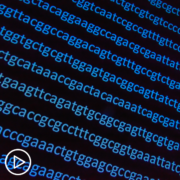Tag Archive for: mutation
An Expert Explains Predictive Biomarker Testing for Lung Cancer
An Expert Explains Predictive Biomarker Testing for Lung Cancer from Patient Empowerment Network on Vimeo.
What is lung cancer biomarker testing? Dr. Grace Dy defines both biomarker and molecular testing and explains how these test results are used in lung cancer patient care.
Dr. Grace Dy is Chief of Thoracic Oncology and Professor of Oncology in the Department of Medicine at Roswell Park Comprehensive Cancer Center in Buffalo, New York. Learn more about Dr. Grace Dy.
See More From INSIST! Lung Cancer
Related Resources:

|
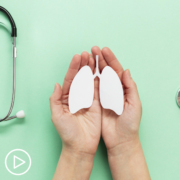
|

|
Transcript:
Dr. Grace Dy:
My name is Grace Dy. I’m a thoracic medical oncologist at Roswell Park Comprehensive Cancer Center here in Buffalo, New York.
Katherine Banwell:
Thank you for being with us today.
Dr. Grace Dy:
Thank you for having me.
Katherine Banwell:
What is biomarker testing, and is this the same as molecular testing for non-small cell lung cancer?
Dr. Grace Dy:
That’s a very good question. So, let’s first maybe define what biomarker means. So, biomarker is an all-encompassing term relating to a measurement of a biological parameter. That’s what it means.
So, you can actually have biomarker related to imaging. So, it’s not specific to a particular test. But what it’s trying to do is to guide doctors in making decisions. So, you can have, for example, a PET scan as a biomarker to indicate the effectiveness of therapy.
So, it’s not specific to a test. So, it’s a broader scope. But in cancer, generally, it’s used interchangeably with molecular testing. And molecular testing is a more focused test on the genetics of the cancer.
In some aspects, sometimes it also refers to testing for proteins, characteristics of different proteins in the cancer. Again, to help doctors generally define what might be a better treatment option that is personalized to the patient’s cancer.
In some instances, the biomarker can also be what we call prognostic, meaning independent of what we do with the treatment, it may define to us how well a patient will survive or have their outcomes, whether they have treatment or not.
So, those are maybe the nuances between a predictive versus a prognostic biomarker. But for all intents and purposes, the most common test that we use for lung cancer patients are what we call predictive biomarker testing. Molecular testing is one of the ones that we often commonly request to help us define treatment modalities, especially in non-small cell lung cancer.
What Should You Know Before Participating in a Breast Cancer Clinical Trial?
What Should You Know Before Participating in a Breast Cancer Clinical Trial? from Patient Empowerment Network on Vimeo.
Is there a point in a patient’s breast cancer care when a clinical trial should be considered? Breast cancer expert Dr. Bhuvaneswari Ramaswamy shares her perspective.
Dr. Bhuvaneswari Ramaswamy is the Section Chief of Breast Medical Oncology and the Director of the Medical Oncology Fellowship Program in Breast Cancer at The Ohio State College of Medicine. Learn more about Dr. Ramaswamy.
See More from Breast Cancer Clinical Trials 201
Related Resources:

|

|

|
Transcript:
Katherine:
Well, what questions should patients ask their team before they even begin a clinical trial?
Dr. Ramaswamy:
I think most important thing, and in – and usually, a doctor would – should really explain this to you, particularly if it’s a little bit of a complex study with a paper and pen. They need to tell you if this is two arms, that you may be randomized into this arm versus this arm. So, what you need to understand is what are the drugs and what are the differences between these two arms? Whether you go into this arm or this arm, are you going to be compromised with your outcomes? And that is important to understand. And now certain arms may have a little bit more blood draws or scans. And so it’s important to understand what it means, what commitment of your time and other things that goes on with different treatments.
So, again, these are important for you to understand. Also, it’s important for you to know what is that experimental drug? What is that new drug? Right? And what data do they have from the past about this drug? Has it been tried in humans before or is this the first in the human study? And what does a target, why is it used in my cancer? How do you think it’s going to work? And what are the side effects that comes with this experimental drug? Mm-hmm. I think for you, the most important thing is to understand what is your commitment because the commitment during clinical trials can increase a little bit. You may have to come in, stay a bit longer to kind of check the drug levels in your body, in your blood, or do more testings, blood draws, and things like that.
Are you willing to do that? That’s something for you to answer. Don’t feel that you need to do this for some reason other than it fits your life and it fits your philosophy, okay? But also don’t push it away thinking that just because you don’t know enough and you’ve heard things from outside, it’s important for you to hear it from your providers and understand it clearly and then make a decision that’s right for you.
When Should Breast Cancer Patients Consider a Clinical Trial?
When Should Breast Cancer Patients Consider a Clinical Trial? from Patient Empowerment Network on Vimeo.
Is there a point in a patient’s breast cancer care when a clinical trial should be considered? Breast cancer expert Dr. Bhuvaneswari Ramaswamy shares her perspective.
Dr. Bhuvaneswari Ramaswamy is the Section Chief of Breast Medical Oncology and the Director of the Medical Oncology Fellowship Program in Breast Cancer at The Ohio State College of Medicine. Learn more about Dr. Ramaswamy.
See More from Breast Cancer Clinical Trials 201
Related Resources:

|
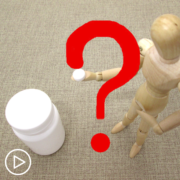
|

|
Transcript:
Katherine:
Let’s talk about where clinical trials fit into a breast cancer treatment plan. When should someone with breast cancer consider a trial?
Dr. Ramaswamy:
And the most important thing again here to understand is clinic – you should consider a clinical trial at all aspects, all parts of your journey through this whole diagnosis and whatever the outcomes that you are going to have. We all have a lot of misconstrued ideas about clinical trials. And one of the thing is we think clinical trials are only when standard of care is not needed like that is that – we don’t have other treatments. That you are coming to a point that you don’t have other treatments and now you should go to clinical trials. That is not true, right? Because the fact that you can have these treatments in your curative setting came because many of the patients before you were willing to go on the trial that compared standard of care, which may not have had that new drug with a competitor to the new drug with the standard of care.
So, nobody gives – the important thing to understand is no one is going to give you a placebo alone for cancer treatment. Think about that. I mean, there’s no way a doctor whose oath is to cure you to help you is going to just give you placebo. So, it is important for you throughout your process to actually ask. In fact, we used to wear a badge to say ask your doctor about clinical trials. So, ask your doctor about it, even if they miss it. Just ask, is there a clinical trial that I could fit in? They’re supposed to look for it, but you don’t need to leave it at that.
Ask at all aspects of your journey for a clinical trial option. If you are not suited for the trial, no provider is going to put you on that trial because everybody has the same goal that you need to get better. Your chances of getting better is high.
What Is Precision Oncology and What Does It Mean for Breast Cancer Patients?
What Is Precision Oncology and What Does It Mean for Breast Cancer Patients? from Patient Empowerment Network on Vimeo.
Are we closer to personalizing breast cancer treatment? Dr. Bhuvaneswari Ramaswamy defines precision oncology and explains the progress being made to make it a reality.
Dr. Bhuvaneswari Ramaswamy is the Section Chief of Breast Medical Oncology and the Director of the Medical Oncology Fellowship Program in Breast Cancer at The Ohio State College of Medicine. Learn more about Dr. Ramaswamy.
See More From INSIST! Metastatic Breast Cancer
Related Resources:
Transcript:
Katherine:
We often hear the term precision oncology. What exactly does that mean?
Dr. Ramaswamy:
So, precision oncology is again, one of the ways that we are getting better, right? So, what we are trying to understand is that originally, we just understood cancer as just where all it is and how spread it is. Again, an anatomical. Now we are getting more and more into the biology. So, in the biology we were focusing more on the RNA. There are two things, the RNA and DNA. DNA is your code, and RNA is the one that comes from the DNA kind of the message that goes, makes the protein, which changes everything in your body. So, we were focusing on the RNA, which are the biomarkers, right? Because we – you that that’s what drives the cancer. Now we are focusing more on the DNA. What is changing within the core, that blueprint in the tumors that is causing resistance that is making cancer cells worse?
Could we target those? And so that is what is precision oncology. They’re trying to understand the genetic core change within your tumor and maybe able to target that. You could have breast cancer, you could have a completely different cancer like lung cancer. But if you have the same genomic change or gene change within the tumor, could we just target that cells and be able to get a really good response? And those are the kind of ways we are going towards. And I can tell you it is as you hear this concept, it sounds like so bizarre. I’ll tell you, I felt the same too when it all started, even as a scientist and an oncologist. But it is truly becoming a reality. And in certainly in more some cancers more than the others, but it’s slowly becoming a reality for all cancers. So definitely, again, a positive and a tailored therapy to the patient. And so that’s what we want.
How Do Biomarker Test Results Impact a Breast Cancer Patient’s Prognosis?
How Do Biomarker Test Results Impact a Breast Cancer Patient’s Prognosis? from Patient Empowerment Network on Vimeo.
What role do biomarker test results play in a breast cancer patient’s prognosis? Dr. Bhuvaneswari Ramaswamy reviews important biomarkers, such as hormone receptor status, and how they affect care.
See More From INSIST! Metastatic Breast Cancer
Related Resources:

What Do You Need to Know About Breast Cancer Genetic Testing? |

|

How Do Genetic Mutations Impact Breast Cancer Risk, Prognosis, and Treatment? |
Transcript:
Katherine:
How do biomarker test results impact prognosis?
Dr. Ramaswamy:
All of them do because it’s important to understand that that’s why this – these biomarkers carry a lot of weight. Biomarkers are good, are important, but when the most important biomarkers are that are going to impact outcomes. And then even more important is whether they’re going to predict the efficacy of a treatment, the outcomes used by the success of a treatment, right?
So, in that way, if your tumor is estrogen and progesterone receptor- positive, then you generally tend to do a little bit better. And they are slightly better tumors for sure, and you know that the anti-estrogens would work. So, these – there’s two ways. They are prognostic and predictive. Now, the whole two positive tumors previously used to have a worse prognosis, but we have such wonderful anti HER2 therapies now that we can use. Now we know that if you use those therapies, the outcomes are better.
So, it’s predictive again, that predictive of the treatment and prognostic. Now the triple negatives are usually a little bit more difficult to treat because as you can understand, they don’t have any of these targets for us to use targeted therapy at this point. There is definitely some improved outcomes using immunotherapy, but you know that we don’t have those proteins. So, slightly worse outcomes for sure, triple negative among all of these subtypes. And also there is no biomarkers.
We do use immunotherapy, which is helping certain percentage of those patients, but we still need to understand why it’s not helping other people. So, yeah.
Genetic Testing VS Biomarker Testing: What’s the Difference?
Genetic Testing VS Biomarker Testing: What’s the Difference? from Patient Empowerment Network on Vimeo.
See More From INSIST! Metastatic Breast Cancer
Related Resources:

What Do You Need to Know About Breast Cancer Genetic Testing? |

|
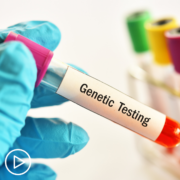
|
Transcript:
Katherine:
Patients are often confused about the difference between hereditary genetic testing and biomarker testing. Would you explain the difference?
Dr. Ramaswamy:
Absolutely. So, the hereditary genetic testing is what are the genes that you got from your parents? It could be mother or father. And we all think that because it’s breast cancer should be just from mother. It doesn’t matter. It can be from mom or dad. And that influences your breast cancer risk. So, if you have some mutations or some changes in certain genes that can increase your risk of breast cancer. And the well-known ones are the BRCA1, BRCA2, but we also now know a few more like the PALB, ATM and CHEK2 and other things.
So, now when you do have a family history, or sometimes even based on your age and your oral history, we do test for this hereditary risk factors that you might have and that may influence your surgery and some type of treatments that we give as well.
Now as far as biomarkers, biomarkers are more proteins that we check in your tumors. The breast cancer that you already have, and that we may do the biopsies. We look for these tumor proteins that influences the growth of your cancer cells. So, we can target these biomarkers and decrease the growth of your cancer cells.
Tools for Accessing Quality Prostate Cancer Care
Tools for Accessing Quality Prostate Cancer Care from Patient Empowerment Network on Vimeo.
What factors could impact a prostate cancer patients access to quality, affordable care? This animated video reviews common obstacles and provides tools and resources to help address barriers to care.
See More From Shared Decision Making: Navigating Prostate Cancer Care
Related Resources:
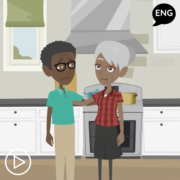
|
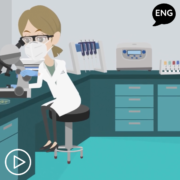
|
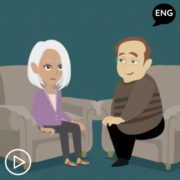
|
Transcript:
Anthony:
Hi! I’m Anthony, and I’m living with advanced prostate cancer. This is Niki, my nurse.
Just like prostate cancer doesn’t behave the same way in every patient, each prostate cancer patient has different factors that could impact their access to quality, affordable care.
Niki:
Exactly, Anthony. There are obstacles that may affect their potential to manage their cancer.
These barriers, which are also called health disparities1, are complex and may include things like:
- Not having health insurance – or having limited insurance.
- Experiencing racism and discrimination.
- Language barriers if English is not the language you are most comfortable with2.
- Cultural barriers.
- Experiencing financial constraints.
- A lack of sick time or paid time off in the workplace.
- Living in a remote or rural area with limited access to care.
- Or, a lack of education or health literacy.
Anthony:
And overcoming or addressing these barriers is the goal of health equity.
Niki:
Right! EVERYONE should have the access to quality care. And while it isn’t possible to solve these problems overnight, there are resources and support services to help people with prostate cancer. It is important to identify and to discuss your barriers with your healthcare team as they are unique to each individual patient.
Anthony:
First and foremost, as we’ve mentioned in prior videos – don’t hesitate to speak up if you feel you are receiving unequal care. You can consider changing doctors if you don’t feel you’re receiving fair treatment, or if you’re not comfortable with your team.
But the burden to access better care shouldn’t fall on you. Your team is there to help, right, Niki?
Niki:
That’s what they are there for! And the best place to start is by reaching out to a nurse navigator or social worker on your team. They may work with you and identify any challenges in your way and offer support resources to guide you in the right direction.
Anthony:
Exactly – my social worker helped me find an organization that provided transportation to and from my treatment appointments.
Niki, are there other services that a nurse navigator or social worker help you connect with?
Niki:
Absolutely – let’s walk through some examples:
- There are resources that can help with the financial strain of cancer care. Patient assistance programs are in place for people who don’t have health insurance or who are underinsured. They are managed by government agencies, pharmaceutical companies, and advocacy groups; and, in some cases, these programs can help cover the cost of medications or provide them at a discounted rate.
- Team members who provide emotional support are available to help you such as a social worker, counselor, therapist, or psychologist.
- If language is a barrier, translators can be made available to join appointments with you, so you can actively participate in your care discussions and decisions. And you can ask for materials in the language you are most comfortable with.
- And if your job is affecting your ability to get care, many advocacy groups have resources that can support you in advocating for your rights in the workplace.
Anthony:
Those are all wonderful support services, Niki.
I also want to add that if you are having trouble understanding your disease, advocacy groups have excellent materials in patient-friendly language. Download the guide that accompanies this video for a list of recommended organizations.
Niki:
That’s right. And, many medical centers have patient advocates available to help you communicate with your team, so you can get the care you need and feel confident in your decisions. Remember, you are not alone!
We hope this video helped you feel more empowered to ask for resources. Thanks for joining us!
Anthony:
And visit powerfulpatients.org/pc to access more videos with Niki and me.
Prostate Cancer Care Partners: Getting the Support You Need
Prostate Cancer Care Partners: Getting the Support You Need from Patient Empowerment Network on Vimeo.
What do care partners need to know to help care for their loved one AND themselves? This animated video reviews the role of a care partner, discusses steps for supporting a loved one and provides tips for maintaining self-care.
See More From Shared Decision Making: Navigating Prostate Cancer Care
Related Resources:

|
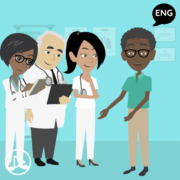
Collaborating With Your Doctor on Your Prostate Cancer Care Plan |
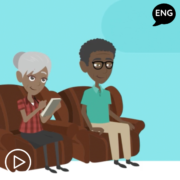
|
Transcript:
Anthony:
Hi! I’m Anthony, and I am living with advanced prostate cancer. This is my nurse, Niki.
And this is my wife, Jane. She’s not just my wife, she’s also my care partner. From helping with my appointment schedule to communicating with my healthcare team, she works with me to manage my prostate cancer.
Jane:
And many of you may be care partners like me. The goal of this video is to help you understand your role and to gain tools to help you support your loved one in their cancer journey. And that includes prioritizing your own self-care.
Niki, we’ve talked about some of the things I do to help Anthony, but how would you describe the role of a care partner?
Niki:
A care partner is someone who works with their loved one on their care every step of the way – from diagnosis to survivorship.
It’s important to mention that anyone can play this role – friend, family member, or loved one – whomever you trust with supporting your health.
Jane:
And there isn’t a single way be a care partner. You can provide support in a way that feels comfortable and natural to you.
Niki, what are some of the ways a care partner can help?
Niki:
Yes – let’s review a few steps. Care partners can assist by:
- Learning about your loved one’s prostate cancer, so you can feel confident in participating in conversations and decisions. You can ask their healthcare team for educational resources.
- And participating in doctors’ appointments by taking notes and requesting post-visit summaries so that you can review the information presented.
- Next, helping your loved one access and use their patient portal and maintaining schedules and organizing medical records.
- Listening to your loved one and assist in weighing the pros and cons of care decisions.
- And monitoring your loved one’s emotional health.
Jane:
That’s a great point, Niki. Sometimes a care partner will notice that their loved one is feeling low or acting differently before they notice anything themselves. Care partners can help communicate these issues to the healthcare team, and can even reach out to a mental health professional or social worker to help.
Niki:
And that leads me to the next important step that many care partners often overlook: Taking care of yourself.
Anthony:
Right – and as we experienced firsthand, this is essential. Jane struggled with making time for herself after I was diagnosed, and it negatively impacted her health.
Jane:
I was totally drained. But adding time for myself on the calendar and keeping up with my self-care appointments made me feel better. What else can you do?
- First, prioritize your health by scheduling and keeping your OWN health care appointment.
- Continue doing the activities that you enjoy – there are ways to make time in the schedule, even if it doesn’t seem like it.
- Find and use strategies that work for you to manage stress, like exercise, reading a book, or anything you find relaxing. Even a short walk with a friend can have a big impact.
- And make a list of tasks you can pass off to friends and family members who offer to help.
Niki:
That’s great advice, Jane. I’ll also add that caring for a loved one can be challenging – it’s normal to feel a range of emotions. If you’re feeling overwhelmed, talking with someone about how you’re feeling can make a difference. And speaking candidly and openly with other care partners in a support group setting can also provide comfort and peace of mind.
Just like Anthony sought the advice of a counselor and social worker, it’s important that Jane find that support SHE needs as a care partner.
Jane:
We hope this video helped you gain tools and strategies for helping support a loved one – and yourself.
Anthony:
Download the guide that goes with this video to review what you learned.
And visit powerfulpatients.org/pc to access more videos with Niki and me.
Living With Prostate Cancer
Living With Prostate Cancer from Patient Empowerment Network on Vimeo.
What follow-up care is important for people with prostate cancer? This animated video discusses support and tools for managing life with prostate cancer.
See More From Shared Decision Making: Navigating Prostate Cancer Care
Related Resources:

|

Collaborating With Your Doctor on Your Prostate Cancer Care Plan |

|
Transcript:
Niki:
Hi! I’m Niki and I’m a nurse practitioner. And here with me is Anthony, who is living with advanced prostate cancer.
Anthony:
Thanks for joining us!
In this video, we’re going to discuss tools for managing life with prostate cancer.
Niki:
Living with prostate cancer means that patients will be monitored for signs that the cancer may be progressing, and assess if it is time to treat the cancer or consider a different treatment plan.
Anthony:
But for all patients, an important part of living with prostate cancer is follow-up care. This may include:
- Disease monitoring and managing symptoms and side effects,
- As well as emotional support.
- And, in some cases, creating a survivorship plan with your team.
Niki:
Let’s start with disease monitoring: This may include regular exams and testing to keep an eye on your disease progression or recovery. And your individual situation and risk will determine the frequency of your appointments.
Anthony:
And for patients like me who have had treatment, managing short and long-term side effects is an essential part of living with prostate cancer.
One issue that can be challenging for some prostate cancer patients is the impact of treatment on a patient’s sexual function and self-image.
Niki:
That’s right, Anthony. It’s important to note that there ARE options that may help manage certain side effects, but you have to talk about them with your healthcare team. While bringing up sexual side effects or bladder control issues to your provider may be difficult, it’s the only way your team can assist you.
Anthony:
In my case, I found it easier to communicate my sexual issues in writing, using the patient portal. Plus – don’t forget that care partners can be a resource to help bring up difficult topics.
Niki:
Exactly – utilize your resources and communicate in a way that you feel most comfortable!
And, as we mentioned, there can also be emotional side effects for men living with prostate cancer. Patients may feel stressed about their diagnosis or anxious about their cancer returning or progressing. Working with a health professional like a social worker, counselor, therapist, or psychologist may help reduce anxiety and worry.
Anthony:
Right – the other approach that really helped me emotionally was participating in a support group.
Support groups allow men to meet and interact with others who are living with prostate cancer and provide a platform to share experiences and information. In a support group setting, it may be easier for men to share details that they don’t necessarily want to share with loved ones.
Niki:
That’s a great point, Anthony. Studies show that participating in a support group can help cancer patients cope with anxiety and depression.
Anthony:
It certainly encourages me to know that other men are facing similar challenges. While my support group meets in person, there are online options for people who prefer to connect in a virtual setting.
Niki:
But as much as it can be reassuring, the support group format isn’t for everyone. Talk to your social worker or counselor about additional support options to find an approach that feels most comfortable to you.
Anthony:
Now that we’ve walked through disease monitoring and resources for emotional support, let’s talk about survivorship. Niki, what is a survivorship care plan?
Niki:
Sure. A survivorship care plan organizes your follow-up care. It may include:
- Information about the treatment you received.
- A follow-up schedule for exams and tests.
- A list of potential symptoms and side effects.
- And lifestyle recommendations to establish and to maintain healthy habits.
Your healthcare team, along with a care partner, can help you develop and stick to a plan.
Anthony:
That’s great advice, Niki. Now that we have learned some tips for living with prostate cancer, what can you do to participate in your follow-up care?
Niki:
- Make sure to schedule and keep regular visits with your team – including your general practitioner – so that all aspects of your health can be monitored.
- Report any new symptoms that you experience – no matter how small.
- Next, don’t hesitate to speak up about lingering side effects – including bladder and sexual side effects – so your team can identify solutions.
- And ask for emotional support and resources.
- Finally, if it’s right for you, talk with your doctor about a survivorship care plan.
Anthony:
Thanks for joining us! Be sure to download the guide that goes with this video to access the information we discussed.
And visit powerfulpatients.org/pc to access more videos with Niki and me.
What You Should Know About Clinical Trials
What You Should Know About Clinical Trials from Patient Empowerment Network on Vimeo.
What do you need to know about prostate cancer clinical trials? This animated video reviews the clinical trial process and provides questions to ask your healthcare team about trial participation.
See More From Shared Decision Making: Navigating Prostate Cancer Care
Related Resources:

Collaborating With Your Doctor on Your Prostate Cancer Care Plan |

|

|
Transcript:
Anthony:
Hi, I’m Anthony, and I’m living with advanced prostate cancer. And this is my nurse practitioner, Niki.
Niki:
Thanks for joining us!
Without medical research, advances in prostate cancer treatment can’t move forward. Throughout this video, Anthony and I are going to discuss a key part of research: clinical trials. We’ll review what they are and how they work.
Anthony:
Niki, what is a clinical trial exactly?
Niki:
Excellent question, Anthony. Clinical trials are research studies in people who have a specific condition, or are healthy volunteers, to help find new ways to treat diseases – like prostate cancer.
Most clinical trials examine the safety and efficacy of medicines, vaccines, and other medical treatments.
And clinical trials are the main path for cancer treatments to be approved. The U.S. Food and Drug Administration – also known as the FDA – requires that all new medicines and treatments go through the clinical trial process before they are approved.
So, why would someone consider participating in a trial? Some people choose to participate to access a potential new medicine or treatment that’s not yet approved to see if it helps their condition. And some people want to help move research forward to help others with the same condition – while other people participate for both reasons.
Anthony:
That’s right – advancing research through participation is an important path to new options for treating prostate cancer.
So, Niki – can you explain how clinical trials are designed to answer key questions?
Niki:
Yes, of course. Most importantly, each clinical trial has a protocol, which is a document that sets guidelines that define and outline the activities of the clinical trial as well as who may be eligible to participate.
The early phase trials determine the safety of the treatment, and the latter phases typically examine if the potential therapy is effective.
All along the way, the study clinic staff – including nurses, researchers, and study doctors –check clinical trial participants regularly to monitor for any safety concerns.
Anthony:
But to be successful, clinical trials require people to volunteer. And people interested in participating will have to meet the trial criteria to participate, correct?
Niki:
Yes, that’s correct, and this can include things like a person’s age, disease stage, prior treatments, and overall health. Remember that everyone’s situation is unique.
Anthony:
And people often have misconceptions about clinical trials that prevent them from considering participation. Let’s run through a few common concerns.
For instance, some people worry that they will receive placebo – which is a non-active medicine – if they participate in a clinical trial. Niki, is this true?
Niki:
A cancer patient would never receive only the placebo without the current standard-of-care and will always be told that the trial will contain a placebo in advance of their participation.
Anthony:
OK, that makes sense. Some people also wonder about the risks and safety of a clinical trial. Niki, can you share some information about this?
Niki:
Great question. Most importantly, research must meet ethical standards to ensure that participants are protected. There is a strict screening and testing process that occurs before a person can participate.
And, clinical trials are voluntary – participants have the right to leave the trial at any time.
Additionally, there is an informed consent process, which ensures that people are fully informed about all potential risks and benefits and helps people understand their rights before taking part.
Anthony:
Ok. Thank you for clearing that up. Niki, what about the misconception that clinical trials are just a last-resort treatment option?
Niki:
They are not just a last-resort option at all, Anthony. No matter when a patient was diagnosed with prostate cancer, or where they are in their care, clinical trial participation may be an option.
Anthony:
So, if someone is interested in participating in a clinical trial or learning more about clinical research – where do they start?
Niki:
Your doctor is the best source of information. You can ask your doctor:
- What trials are available to me?
- Is there a clinical trial that you would recommend for me? Why?
- What are the possible risks and advantages of participating in this clinical trial?
- Are there costs associated with the trial, and will my health insurance help cover costs? And if not, is there financial assistance available?
- Where is the trial being conducted? Is there a clinical trial available to me in my local community? If the trial isn’t nearby or convenient, is there transportation and/or housing assistance?
- Finally, if you want to learn more about ongoing prostate cancer research and clinical trials, ask your doctor for a list of credible resources.
Anthony:
Be sure to download the guide that accompanies this video to access a list of these questions and to help you review what you learned.
Niki:
Thanks for joining us! And visit powerfulpatients.org/pc to access more videos with Anthony and me.
Collaborating With Your Doctor on Your Prostate Cancer Care Plan
Collaborating With Your Doctor on Your Prostate Cancer Care Plan from Patient Empowerment Network on Vimeo.
How can you engage in your prostate cancer care? In this animated video, you will learn about factors that may impact a prostate cancer care plan and tools for partnering with your healthcare team on treatment decisions.
See More From Shared Decision Making: Navigating Prostate Cancer Care
Related Resources:

|

|

|
Transcript:
Niki:
Hi, thanks for joining us! I’m Niki, and I’m a prostate cancer nurse practitioner. And here with me is Anthony, who is living with advanced prostate cancer.
Anthony:
Throughout this video, Niki and I are going to discuss factors that may impact a patient’s prostate cancer care plan.
And as we’ve mentioned in previous videos, it’s important to set goals with your team and understand all of your options before deciding on an approach.
Niki:
Right, Anthony. So, what could impact a treatment plan decision? Factors may include:
- Your age and overall health, including any existing conditions that you may have.
- Disease-related symptoms may also affect your options.
- The stage and grade of your prostate cancer and whether you need to be treated right away.
- Test results, including genomic testing, which identifies the presence of genetic mutations in the cancer and may inform how your cancer will behave.
- Possible side effects, both short term and long term, may also affect your choices.
Anthony:
And, of course, your personal preference should guide the decision as well as how the option may impact your lifestyle. Be open with your care team about what’s important to you and be clear with your goals, including life plans and personal commitments.
Here are some tips to take a more proactive role in your care:
- Talk with close family members and friends about your options.
- Consider a second opinion to help confirm your approach.
- Talk to your healthcare team about your condition and care options. And ask them for resources available to you, including financial help and emotional support, when making decisions.
- You can also visit advocacy group websites that have information about prostate cancer, treatment options, and support groups, to help you understand what’s available.
Niki:
Those are great tips! It’s also a good idea to ask your doctor what they feel is the best approach for you and why. Remember, there is no one-size-fits all approach, and what works for one person may not work for you.
Anthony:
Thanks for joining us! Be sure to download the guide that accompanies this video to help you review what you learned.
And visit powerfulpatients.org/pc to access more videos with Niki and me.
Clinical Trials As a Prostate Cancer Treatment Option | What You Should Know
Clinical Trials as a Prostate Cancer Treatment Option | What You Should Know from Patient Empowerment Network on Vimeo.
Should you consider participating in a prostate cancer clinical trial? Dr. Sumit Subudhi explains the clinical trial process, addresses common trial patient concerns, and provides key advice for trial participation. Dr. Subudhi also shares an update on promising prostate cancer research.
Dr. Sumit Subudhi is an Associate Professor in the Department of Genitourinary Medical Oncology, Division of Cancer Medicine at The University of Texas MD Anderson Cancer Center.
See More From Prostate Clinical Trials 201
Related Resources

What Questions Should Prostate Cancer Patients Ask About Clinical Trails? |

|

Tools for Choosing the Right Prostate Cancer Treatment Approach |
Transcript:
Katherine Banwell:
Hello and welcome. I’m Katherine Banwell, your host for today’s program. Today we’re going to discuss prostate cancer research advances and the role of clinical trials and moving treatment developments forward. Before we meet our guest, let’s review a few important details.
The reminder email you received about this program contains a link to a program resource guide.
If you haven’t already, click that link to access information to follow along during the webinar. At the end of this program, you will receive a link to a program survey. This will allow you to provide feedback about your experience today, and it will help us plan future webinars.
Finally, before we get into the discussion, please remember that this program is not a substitute for seeking medical advice. Please refer to your healthcare team about what might be best for you.
Well, let’s meet our guest today. Joining me is Dr. Sumit Subudhi. Dr. Subudhi, thanks for being with us. Would you introduce yourself?
Dr. Subudhi:
Hi. I’m Sumit Subudhi. I’m an associate professor in the GU Medical Oncology department at MD Anderson Cancer Center. And I exclusively treat patients with advanced prostate cancer. And I’ve been doing it for about a decade.
Katherine:
Thank you. I’d like to begin with an update on prostate cancer research. Would you walk us through the newer classes of treatments that are showing promise?
Dr. Subudhi:
Yeah, in clinical trials, there are classes of drugs known as androgen receptor degraders. And so, the androgen receptor is a protein that basically is the mouth of the prostate cancer. That’s how I like to describe it. And it actually allows testosterone, which is the food, to be eaten by the mouth, and it actually helps the cancer grow.
And what these drugs do is they actually degrade or break down the mouth of the cancer. And, therefore, it starves the cancer to death, and that’s actually the concept. And they seem to be showing some exciting activity in clinical trials, especially in those patients who are resistant to the second-generation hormonal drug that you may have heard of already, such as enzalutamide (Xtandi), apalutamide (Erleada), and darolutamide (Nubeqa). So, I think is something that we’re looking forward to seeing more data on.
Another class of drugs are antibody drug conjugates or ADCs.
And these are what I think of as heat-seeking missiles. So, one part of the drug actually recognizes the cancer, and the other part of the drug actually has a payload that sort of releases a bomb or sort of like chemotherapy-type agent right where the cancer’s located and kills the cancer in that way. And we’re seeing some great clinical activity in prostate cancer with this class of drugs.
And then the final one is bispecifics, and in particular T-cell bispecifics. So, T cells are part of the immune system that actually help kill the cancer.
And, unfortunately, prostate cancer, like some other cancers like pancreatic and glioblastoma, have few T cells inside it. And, therefore, a lot of the immunotherapies that many people have heard about, such as ipilimumab (Yervoy) and pembrolizumab (Keytruda), they’re not very responsive in patients with prostate cancer. And it’s because there’s few T cells in prostate cancer.
What the T-cell bispecifics do is they actually have one part of the drug that actually recognizes the cancer and the other part that recognizes T cells. So, like a bulldozer, it brings T cells right into the prostate cancer and helps kill the cancer that way.
Katherine:
Now there are some inhibitors as well. Is that correct?
Dr. Subudhi:
Yeah. So, the immune checkpoint inhibitors have been around for a while. And, basically, in combination, they seem to be more effective in prostate cancer. But when given alone as monotherapy, they’re less effective.
Katherine:
Are these treatments specifically for patients with advanced prostate cancer?
Dr. Subudhi:
All of them are actually in trials in patients with advanced prostate cancer. And I define advanced prostate cancer as either having metastatic disease, meaning the cancer has spread to other parts of the body outside of the prostate.
Examples include lymph node, the bone, the lung, the liver. But there are so few trials in patients with locally advanced prostate cancer. What I mean by that is they have high-grade prostate cancer, but it’s local, or it’s just in regional lymph nodes. And some of these classes of drugs are being evaluated in that setting as well.
Katherine:
Let’s shift to talk about your research. What are you excited about right now?
Dr. Subudhi:
So, my research focuses on immune checkpoint therapies, which are the inhibitors that you were referring to and understanding how to make them work better in prostate cancer.
And we’re finding out that in prostate cancer there’s about 20 to 25 percent of patients that appear to respond to this type of treatment. But these are patients that don’t have a lot of bone metastases. And these immune checkpoint inhibitors are given in combination. So, they’re not given alone. They’re given with either a combination of anti-CD34 and anti-PD-1 or some other form of that.
Katherine:
Prostate cancer research really can only move forward through clinical trials and patient participation in those trials. Can you briefly explain what a trial is for people who may not be familiar with the term?
Dr. Subudhi:
That’s a great question. My own father has prostate cancer. And he had the same exact question when he started his journey in that.
And so, what I explained to him is that clinical trials are experiments. They’re experiments that are done in our patients.
So, they’re drugs that are thought to mechanistically kill the cancer cell or at least change the environment around the cancer cell to help people live longer. But these drugs were actually tested in mouse models or in tissue models. And we don’t know if they actually work in patients.
And so, in clinical trials, we’re actually testing whether these drugs are safe and whether they’re efficacious or beneficial to our patients. So, I want to be very clear. When patients go on clinical trials, we don’t know if it’s going to work on them. And that’s something that they should know that they’re showing a lot of courage and risk in joining these trials.
But the other point I want to make is that every standard of care drug that is out there actually went through the clinical trial process, and they were approved because they showed benefit in a group of patients.
Katherine:
Well, how can a prostate cancer patient benefit from participating in a trial?
Dr. Subudhi:
One of the key benefits is that you get access to drugs that may actually prolong your life or even cure you and that you wouldn’t have access to in trials.
And so, some of my patients, unfortunately, they’ve exhausted all the standard of care choices that are out there. And the trial’s the only option left versus leaving it up to natural causes of demise from prostate cancer. And so, clinical trials give other opportunities to potentially live longer and have a great quality of life.
Katherine:
So, they could offer some hope.
Dr. Subudhi:
Definitely. As far as I’m concerned, yes. And, actually, with my patients, I try to not wait while they’ve exhausted all the treatments to start them on clinical trials, because I feel like we may be able to save some of these treatments in our back pocket for when they’re too exhausted to be coming to our clinic so often. And so, I like to actually try to get them enrolled in clinical trials early on in their journey with prostate cancer.
Katherine:
I’d like to define some clinical trial terminology to help patients further understand the process. Let’s start with the phases. What occurs during each phase?
Dr. Subudhi:
So, great question. Phase I is the safety phase. So, all we’re trying to do is find the right dose of the drug that is actually safe to give in the patients. And we’re looking for the maximum tolerated dose. And once we find that dose, then we use that dose to go to Phase II of the trial. And Phase II trials are looking at efficacy. So, looking to see whether the trial is giving you any clinical benefit, meaning the cancer’s shrinking or even disappearing.
Katherine:
Go on.
Dr. Subudhi:
And then the third phase is Phase III where you’re testing the current drug, experimental drug, to either standard of care or to a placebo to see whether or not you get a benefit, either a progression-free survival benefit or overall survival benefit. And so, those are the three phases of clinical trials.
Katherine:
What are the different types of clinical trials?
Dr. Subudhi:
So, they’re controlled trials. Actually, I should back up. So, there’s open-label trials where everyone that enrolls in the trial will get the experimental drug. So, there is no control arms in these trials. Then there is the control trials where you can either get the drug, or you may get a placebo or standard of care drug.
There are some trials that allow for crossover, meaning that if you’re in the placebo or standard of care arm, if your cancer progresses, you can actually cross over and get the experimental drug. But I just want to be clear that not all clinical trials have crossover. And if you’re in a control trial, I think that’s an important question to ask your doctors about that.
But the reason why we do the control trials is that we’ve learned that using historical controls – for example, we’re doing a lot of combination studies with chemotherapy, such as docetaxel (Taxotere), which was FDA-approved in 2004. So, if we’re using historical data from almost 20 years ago, it’s not the same thing as our patients that are being treated with docetaxel now, because their treatment landscape has changed so much, and our patients have changed so much.
And so, for that reason, control trials give us a better sense of how effective this experimental drug is doing as opposed to comparing it to a historical perspective.
Katherine:
What other types of clinical trials are available?
Dr. Subudhi:
So, there are a few other options. So, we talked about open-label where everyone’s guaranteed to get the drug. We talked about a controlled study where you will either get one drug or another. And another type is a randomized trial where a computer decides whether or not you’re going to actually get one drug versus another. It’s not your doctor because a lot of people think that I’m making that decision, and I’m not. It’s actually a random computer.
And some trials have 1:1 ratio, meaning a 50 percent chance that you’ll get the experimental drug versus the control drug. But other trials have 1:2 ratio or 1:3 ratio. So, that’s something that, again, you have to ask your physician of how these trials are being randomized.
Katherine:
Well, in a randomized clinical trial, the patient isn’t going to know what drug they’re being given.
Dr. Subudhi:
Actually, that’s not true.
Katherine:
Oh, it’s not.
Dr. Subudhi:
So, you bring up a great question. So, there’s a double-blind randomized clinical trial where not only the patient doesn’t know, but even the physicians and the nurses. No one except for the pharmaceutical company that’s running the trial actually knows who’s actually getting which drug. And it’s only towards the end of the trial that we unblind, and then we share that information. Well, the pharmaceutical company first shares it with the medical team who then shares it with the patient.
Katherine:
I see. Are there other common clinical trial terms that you think patients should know about and understand?
Dr. Subudhi:
I think for now those are…
Katherine:
…they’re the most important?
Dr. Subudhi:
I think to me those are the most important. And I think that sometimes too much information can bog us down.
Katherine:
Well, speaking of information, there is a lot out there, some of which may not be very reliable. And that could lead many patients to having misconceptions about clinical trials. Let’s walk through a few common concerns we’ve heard from our community about trials.
One frequent question is – will I receive a placebo instead of a real treatment? And, first, I’d like you to define placebo. And should this be a concern for patients?
Dr. Subudhi:
Right. So, placebo is a drug that looks similar to the experimental drug. For example, if the experimental drug is a blue pill, then the placebo will be a blue pill. But it will be a pill that should have no known biological activity.
If the experimental drug is given intravenously and you get it in a liquid bag, then the placebo will also come in a liquid bag. So, it will look the same. And that’s why both the medical team as well as the patients or their families will not know which drug the patients have received, meaning the experimental drug or the placebo. But the placebos are meant to not have any biological activity.
Katherine:
So, it shouldn’t be a concern to patients then.
Dr. Subudhi:
Well, the concern that most of my patients share with me when they hear about placebo-controlled trials is, “Well, if I’m not going to get the experimental drug, why should I do this? I mean what benefit does it have for me?” And so, I tell them that one of the benefits is that we are watching you very carefully.
Because we don’t know sometimes which drug you’re getting. But in some control trials, like a randomized control trial, we will know because I’m not blinded.
If you’re in the arm that’s only getting chemotherapy, well, you know you’re not getting an oral pill. So, it’s very clear to the patient what they’re getting. But if they’re getting an oral pill that’s a placebo, we’re watching them very carefully.
So, we’re watching the patients very carefully in these placebo-controlled trials. And they’re coming in often so that we’re not going to miss any devastating things happening from the cancer. In fact, we’ll pick it up earlier than if they were just getting a standard of care outside of a trial. And for that reason I tell that my patients, “Don’t be worried.” And I always make sure that I have a backup plan.
So, the backup plan is either they’re going to cross over, meaning the trial allows for them to cross over to get the experimental drug. Or I have another trial that I know that they will qualify for. Or the third alternative is that I actually have a standard of care drug that I’m ready to give them the second I have it so that they don’t have to have those concerns.
Katherine:
That’s really great information to have. Patients also often have questions about safety. So, what are the risks of clinical trial participation?
Dr. Subudhi:
So, safety is a major issue, especially more into the Phase I. The Phase I trial, if you remember, are the trials where we’re dose escalating, meaning we start off with a small cohort of patients, maybe three to five patients. And we give one dose of the drug. We see if it’s safe. If it’s safe, then we go to the next dosing level. And we just keep going until we find a dose that may be too toxic or too unsafe for our patient.
So, in the Phase I, we have less information, especially in the first-in-human drugs. But in those cases, we are watching you carefully to make sure that nothing bad happens to you.
But the problem with those trials is it requires a lot of time at the institution or with your doctor. For example, I’m doing a bispecific trial where we have to keep the patients inside the hospital for eight days, purely for safety reasons. They’re not getting the drug for all eight days. But we’re just keeping them under observation so in case anything bad happens we’re ready to react because we know that if something bad happens at their home in that first eight days, it could actually risk their lives.
So, in those cases, some trials, if we’re concerned about safety, you’ll be spending more time in the doctor’s office or in a hospital being evaluated. So, that’s the one negative. But sometimes, the trials that can be more exhausting as far as the amount of time it takes you away from your home and family are the ones that have the most reward.
Katherine:
Well, what protocols are in place to protect patients?
Dr. Subudhi:
So, when they sign up for a protocol, we are instructed to give them our best information. So, let’s say it’s a first-in-human drug. Well, usually, first-in-human drugs are tested in other mammals, such as monkeys, and we look for toxicities there. And we have signs of what’s going to happen. Sometimes, a first-in-human drug is part of a class of drugs, like I talked to you about T-cell bispecifics.
Well, there’s several T-cell bispecifics out there. And we’ve learned that this class of drugs has a unique set of side effects that they all tend to have. Some have it more, and some have it less.
But when we’re discussing this with you or the patient, we are actually going to go through each and all of these side effects. Now, me personally, my patients that go on my trials, they all get my cellphone number so they have 24/7 access to me because I know they’re taking a risk. And it’s a lot of courage to go on these trials. And it’s scary. And I want to make sure they don’t feel like they’re ever alone.
Katherine:
Another common concern we hear is that a clinical trial is only considered when there are no other treatment options available for a patient. What are your thoughts on this?
Dr. Subudhi:
There’s a lot of my colleagues in the field that feel that way. And I know a lot of patients’ misconceptions are also that way. And that’s partly because of Hollywood and movies and TV shows that we watch. But I think that many people, especially in the medical field, think of clinical trials as the last resort.
And I actually disagree with that. I think that I like to actually start my patients with one or two standard of care treatments. But after that, really start putting clinical trials in between. And we have to remember that there’s not always a clinical trial available that the patient actually meets the criteria for.
So, it’s always disheartening in clinic when I meet someone for the very first time who was referred to me because they exhausted everything. And we just don’t have any clinical trials available, or they’re so weak from the cancer and all the prior treatments that they don’t qualify for a clinical trial. And then I really don’t have anything else to give them.
So, my personal approach is to try to put clinical trials in between and always have something in my back pocket so that if they get a bit exhausted or they want to spend more time with friends and family, they can get the standard of care treatment.
Katherine:
If a patient is interested in participating in a trial, what’s the best way to find out which trials might be available for them and right for them?
Dr. Subudhi:
So, that’s a great question. I think number one is always ask your oncologist, and they’re a great resource. But also, there’s websites. So, for different types of cancer – so, example, I do prostate cancer. So, the Prostate Cancer Foundation or PCF.org is a wonderful resource that will give you a list of cutting-edge trials.
In addition, the government has clinicaltrials.gov. And that’s where you can actually type in your cancer type and different criteria, and you’ll get a list of trials.
Katherine:
That’s good to know. What questions should patients ask their healthcare team when considering joining a trial?
Dr. Subudhi:
I would ask them, “Would you do it yourself if you were in my situation?”
Katherine:
Very good.
Dr. Subudhi:
I think that’s a very important thing to ask.
Katherine:
Are there barriers that interfere with patients’ access to clinical trials? I think you touched on this but maybe if you have anything to add.
Dr. Subudhi:
Yeah. So, travel can be a major barrier. And that’s something that the pharmaceutical industry understands. And, therefore, some of the trials, especially the multicenter trials, actually allow for travel cost. That sometimes includes flights, driving, hotels, food.
So, that’s something that’s important to ask because sometimes when we’re thinking about clinical trials, we’re so anxious in the doctor’s office. And then it’s not until we go back home when we’re trying to figure out how do we get the resources to come so frequently. You’ll find out that’s sometimes travel costs.
The other thing is underrepresented minorities are something that we’ve been doing a relatively poor job recruiting to our clinical trials. Part of that is just from history that we didn’t have the safety rules in place that we do now. And underrepresented minorities were affected negatively in some of the earlier trials.
And the other thing is just the resources of getting to and from their homes to our cancer site as often as they need to because they may be the sole breadwinner in their homes and things like that. So, there are resources to try to help do this. But I still think we have to do a better job.
Katherine:
Can trials be coordinated between a local doc and the institution?
Dr. Subudhi:
So, most trials cannot. Most. But there are some that can. So, if it’s a standard of care treatment, sometimes we can have the safety visits done with the local doctors. But every time they’re going to get the treatment they have to come see us at the institution that is actually running the trial.
But most of the time, what I tell all my patients is, “I want them to have a local doctor.” Because if there’s something that happens in the middle of the night, I want to be able to say, “You’re going to go to this emergency room where this doctor works.” And then when they go there, as soon as they get admitted into the emergency room center, I talk to the ER doctor, and I say, “This is what I want to be done. These are how these drugs work.”
Because they’re not going to know what these experimental drugs are. They’re not available in the community. So, I just think it’s important to have communication, especially for our patients that are out of state. MD Anderson is in Houston, Texas. And Texas is so big that a lot of my patients live six to eight hours away, and they’re still in Texas.
Katherine:
Oh, wow. So, what are your thoughts on what could be done to overcome the barriers that some patients are experiencing? And are there resources available?
Dr. Subudhi:
So, the pharmaceutical companies are putting in more financial resources as well as a diversity resource. And when I say diversity resources, those outreach programs just to make sure that the communities that are underserved are hearing about the clinical trials because if you don’t hear about it you’re never going to join it. So, one thing is just knowledge.
And then, number two, we’re trying to create financial resources. For example, there’s Angel Flight as one example where they will pay for the flight for you. And they’ll put you on maybe a chartered plane or something or a smaller plane to defray the cost of traveling by air. So, there are things out there, but we still need a lot more.
Katherine:
But one thing patients could do is talk to their healthcare team about what resources are available for them.
Dr. Subudhi:
Absolutely. Absolutely.
Katherine:
Before we end the program, Dr. Subudhi, I’d like to get your final thoughts. What message do you want to leave the audience with related to clinical trial participation?
Dr. Subudhi:
First of all, thank you for even thinking about it. That’s the one big step. And for those of you who actually take the next step and actually join a clinical trial, again, thank you for being so brave.
I think it’s a gift that you’re giving to other fellow patients with cancer. And it’s also a gift that you’re giving to the scientific and medical community, because we are learning by your participation in the trial. And I want you to know whether the trial worked for you or does not work for you, regardless, we’re going to learn something that’s going to help change outcomes in your cancer.
Katherine:
Dr. Subudhi, thank you so much for taking the time to join us today.
Dr. Subudhi:
Well, thank you. I really appreciate it.
Katherine:
And thank you to all of our partners. If you would like to watch this webinar again, there will be a replay available soon. You’ll receive an email when it’s ready.
And don’t forget to take the survey immediately following this webinar. It will help us as we plan programs in the future. To learn more about prostate cancer and to access tools to help you become a proactive patient, visit powerfulpatients.org. I’m Katherine Banwell. Thank you for being with us.
What Does Active Surveillance Mean for Prostate Cancer?
What Does Active Surveillance Mean for Prostate Cancer? from Patient Empowerment Network on Vimeo.
Prostate cancer care may include active surveillance, but what does it mean exactly? Expert Dr. Tanya Dorff explains this approach and how it is used to monitor patients with prostate cancer.
Dr. Tanya Dorff is Associate Professor in the Department of Medical Oncology & Therapeutics Research at City of Hope. Learn more about Dr. Dorff.
Related Resources:

|

|
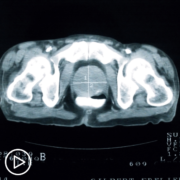
|
Transcript:
Dr. Dorff:
Active surveillance is different than what some people think it is. So, some people think it means we’re not going to treat the cancer, that we’re just going to let it take its natural course. It’s actually quite active, as the name implies. We’re really trying to get to know a person’s cancer and understand whether it is a cancer that will ultimately need to be treated, in which case we will intervene with definitive treatment, whether that be radiation or surgery, but the goal is to find those patients whose cancer is not very aggressive and may never need to be treated so that they can avoid the possible risks that come from definitive local therapy.
Katherine:
So it’s more like a watch-and-wait situation?
Dr. Dorff:
But it’s…I, again, view it as a little bit different than that. Watch and wait is “let’s just let it do what it’s going to do.” Active surveillance is what I call a getting-to-know-you period. Let’s understand whether these clinical features that have signaled that your cancer may be low-risk, may not need treatment – let’s see if that really plays out, let’s make sure we haven’t missed anything, and if your cancer needs treatment, we’re going to treat it.
HCP Roundtable: Overcoming Lung Cancer Biomarker Testing Challenges
HCP Roundtable: Overcoming Lung Cancer Biomarker Testing Challenges from Patient Empowerment Network on Vimeo.
The lung cancer field continues to experience tremendous growth in precision medicine. Oncologists have more tools to treat lung cancer, but access and language remains a big factor in biomarker testing. Drs. Jessica Bauman and Lyudmila Bazhenova discuss current issues in NSCLC biomarker testing, insights on how providers can explain biomarker testing to their patients and their families, and how academic centers and community physicians can work together to overcome challenges in biomarker testing.
See More from Lung Cancer | Empowering Providers to Empower Patients
Related Resources:

|

|
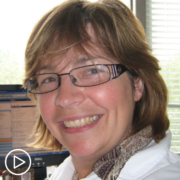
|
Transcript:
Dr. Nicole Rochester:
Welcome to the Empowering Providers to Empower Patients or EPEP program. I’m Dr. Nicole Rochester, a pediatrician and the founder of Your GPS Doc. In this unique program, we connect leading lung cancer expert voices to discuss enhancing physician patient communication and share decision making in lung cancer care. Some of the questions we’re going to talk about today include, what are the major successes and challenges around biomarker testing? How can experts in academic settings work with those in community settings to overcome challenges in biomarker testing? And also, what are the best practices for discussing and explaining biomarker testing to your lung cancer patients?
Thank you. I’m thrilled to be joined today by noted lung cancer medical oncologist, Dr. Jessica Bauman from Fox Chase Cancer Center in Philadelphia, and Dr. Luda Bazhenova from UC San Diego Medical Center. Thank you both for joining us in today’s round table.
Dr. Jessica Bauman:
Thanks for having us.
Dr. Lyudmila Bazhenova:
My pleasure should be here as well.
Dr. Nicole Rochester:
Thankfully, research in lung cancer is ongoing and remains at a fast pace, but with that pace often comes challenges of keeping everyone up to date, providers included. So we have a lot to cover today. So I want to start by just providing a general overview of biomarker testing and lung cancer therapy. So I’m going to start with you, Dr. Bauman. Can you discuss some of the general guidelines for…sorry. So I’m going to start with you, Dr. Bauman. Can you discuss existing guidelines for genomic biomarker testing for lung cancer?
Dr. Jessica Bauman:
Sure. I’d be happy to. So genomic and biomarker testing in general has really been at the forefront of many conversations about lung cancer over the course of the last decade or longer, 20 years. Because it has really changed our approach to patient care and individualized the way that we treat and make decisions about patients with lung cancer. And so what this means, is for every single person who has a new diagnosis of lung cancer, essentially everybody is now recommended to have molecular testing on their individual tumor samples to help us decide what treatment decisions are the best for them. Now, it used to be that this was really only recommended for patients with a new diagnosis of metastatic lung cancer, but now we’re seeing this really influenced decision-making earlier on than the metastatic setting.
And so we now have treatment approaches that change based on molecular testing for early stage one cancer as well. And so, although it used to be more of a later stage, necessity, now we really…we really now need the information sooner than ever before. And when we say molecular testing, this is really looking at the individual tumor and what is potentially driving the cancer to grow. So to look for oncogenic drivers that change treatment. So I call this with my patients, I call this the alphabet soup. But this includes, EGFR mutations, ALK, ROS1, RET, HER2 as well as many others that influence the potential treatment options that we have for our patients.
Dr. Nicole Rochester:
Awesome, thank you. That is a great overview. Do you have anything to add to that, Dr. Bazhenova?
Dr. Lyudmila Bazhenova: No, I think that was very nicely summarized. I think an important thing is that we have to test, we cannot guess. We have to know what our patients…what mutations our patients have, and then we have to know what to do with that. That’s kind of a second part of the question.
Dr. Nicole Rochester:
Wonderful. So it sounds like this is really kind of revolutionary in the sense that, like you said, we can now provide very individualized treatment for lung cancer patients. So I’d love for the two of you to talk about some of the successes in testing over the past decade for lung cancer patients. And we’ll start with you this time, Dr. Bazhenova.
Dr. Lyudmila Bazhenova:
I think our successes actually became our challenges. We have seen an explosion of targetable oncogenic drivers. If you look at the FDA approvals for oncogenic driven therapy, we have a first approval in 2004 and then there was kind of a silence for almost a decade. And then starting in 2014, every year we now have three or four drugs approved. And also those drugs are being approved for the same indication, but different companies. So I think it is very hard for a practicing oncologist who have diseases other than lung cancer to actually keep up with exploding information that they need to know. And I think that’s why I say our success is our challenge, our success is that we are now in lung cancer have 10 oncogenic drivers that we have treatment for.
Our challenge is to remember that there are 10 oncogenic drivers. It’s becoming even more complicated because if you take, for example, an EGFR story, we don’t just need to know that the patient has an EGFR mutation. We need to know what type of EGFR mutation we have, that patient has. And it is no longer three categories. Like even looking in atypical mutations, we now separate out so-called pack mutations, which are treated differently than anything else. So it’s difficult for a practicing physician, or mid-level practitioner to remember what even to do for lung cancer, but they have to do a breast cancer and colon cancer and everything else. So it is a challenge currently.
Dr. Nicole Rochester:
I appreciate you highlighting that. A lot of times it’s like a double-edged sword, right? What are your thoughts, Dr. Bauman, and in terms of the successes as well as some of the challenges?
Dr. Jessica Bauman:
So I absolutely echo what Dr. Bazhenova is saying in terms of the amazing successes, right? We now have for multiple different populations, we have an oral medication that can treat their cancer with the hope that it keeps that cancer under control for many, many months and for some people even years. And I think the challenge is absolutely keeping track of all of those different mutations and then what is actually targetable. And if you have, is it a mutation? Is it a fusion? Is it… What exactly is it that allows you to then use that targetable therapy? Is certainly one challenge. The other challenge is getting that information as soon as we can get it. So you can imagine, so somebody comes in to see me with a new diagnosis of metastatic lung cancer, right? Their biopsy was done say two weeks at a different hospital, and their first scan was done six weeks ago.
So now they’re already six weeks into the concern of a diagnosis of lung cancer, and they’re symptomatic and they come to see me and say, what am I going to do? And we have to get all of that information as fast as we can, because it completely changes the way we’re going to treat them. And so creating systems, in particular reflex testing systems such that this is sent immediately so that by the time they’re seeing me we already have this information is really important. But that, I think that is sort of at its infancy. At Fox Chase, we’ve worked on our sort of reflex system for a very long time. And it’s still, every time there’s a new approval, it seems like it changes slightly or there’s a new system that we have to think about it. But at the end of the day we also…one of the challenges is making sure that we streamline the processes in which we get this information in the best way we can because tissue can be limited.
There is a lot, making sure that you actually get adequate tissue sampling to be able to test for everything that you need to test for is really important. Then figuring out where to send the testing. Many academic centers have internal panels that they send for molecular testing, but there are so many different companies that advertise doing some kind of molecular testing. And so knowing which of those companies to consider using, what they’re offering, which ones offer RNA sequencing, for example, because that is a particularly important aspect, in addition to DNA sequencing that we need. And so sort of keeping track of all of that is particularly challenging. And then I think the last thing is, I think it’s the needing this information earlier and earlier in a diagnosis.
Dr. Jessica Bauman:
And so once upon a time, it really was the medical oncologist who could drive this and run the show because it was really, we needed it for somebody with metastatic disease, right? And we’re sort of the captains of the ship per se, when someone has a new diagnosis of metastatic disease. However, now there’s adjuvant therapy for patients who have EGFR mutations after a surgical resection. And so we need, the surgeons also need to really understand that we need this information. And they often are now getting these tests before a medical oncologist even sees the patients. And so it isn’t just medical oncology, it’s also now, it’s going into multiple different specialties who also need to understand what these mutations mean and what to do about them, and then how it influences therapies.
Dr. Nicole Rochester:
Wow, you all have really done such a great job highlighting both the successes and the challenges. And it’s a perfect segue into my next question because you just alluded to, Dr. Bauman, this idea of academic medical centers and the challenges that you all are facing in cancer centers. And we know that many patients are receiving their care in the community, and in fact, sometimes it’s this dichotomy between what happens in the academic setting and the community setting that can actually create and perpetuate disparities. So my next question really has to do with how can lung cancer experts in academic settings partner with, collaborate, work with those experts in the community settings to overcome some of these challenges that you all just talked about as it relates to biomarker testing? So I’ll start with you, Dr. Bauman.
Dr. Jessica Bauman:
So, that’s a million dollar question. I do think there are many opportunities of educational opportunities to continue to educate everybody in terms of lung cancer. I think lung cancer is a very common diagnosis. And so we know that many community providers absolutely deliver excellent lung cancer care. And so making sure that there are many opportunities for them to participate in, either citywide or nationwide educational opportunities for updates on lung cancer. We have in Philadelphia, we actually have an academic, sort of a multi-multidisciplinary, multi-institutional tumor board, thoracic tumor board that happens quarterly, which we invite community providers to to discuss some of the latest literature. Certainly our emails are always available, so we can always bring there, certainly we get many different questions that come in from other providers, but I’m sure we could do a better job. And I’m very curious to hear what Dr. Bazhenova thinks about this as well, because I think it is such a huge challenge.
Dr. Lyudmila Bazhenova:
I agree with you fully, and I think my two cents here is I think we have to recognize and accept that one size does not fit all in this situation. And whatever works for my institution is probably not going to work for a smaller community practice. But as long as we recognize that this needs to be done and each community practice can work with their stakeholders in the molecular testing pathway, like molecular pathologists, regular pathologists, surgeons. Each institution has power to establish their own internal pathways. Would it be what Dr. Bauman says, reflex testing, which is probably not going to be an option for a majority of the community setting because they do not have their own NGS. It’s going to be a sendout. Or like in our institutions, we don’t have a reflex molecular testing. It’s us medical oncologists who are ordering it, but we kind of get it on the backside.
We can get the patient in within 24, 48 hours from the consult was put in. And so that’s why we didn’t do the reflex testing, but as the reason we did it is because we sat down as a team and we decided this is what works for us. So I encouraged the community groups again, sitting down saying, okay, the task in hand is lung cancer patient has to have molecular testing at the time of the diagnosis. How are we going to get it and how are we going to make sure that we are not missing, you know, have some kind of internal QI, and make sure you know what your practice is doing rather than assuming that your practice is doing molecular testing for all the patients.
Dr. Nicole Rochester:
Thank you so much. Did you have something you wanted to add, Dr. Bauman?
Dr. Jessica Bauman:
Yeah, I was just going to say, and I think that so many things are happening before they ever see us, that includes a pulmonologist is going in and doing a biopsy, right? Or an interventional radiologist is getting a biopsy. So it has to start way upfront of the actual diagnosis because the, what you want to try to get to capture the information as soon as you can, right? So you don’t want to get just an FNA biopsy, for example, of a liver lesion knowing that three weeks later what you really need is a core biopsy, right? So it really, the path you do, it involves so many different stakeholders when you’re having conversations about how to streamline this for your own institution and practice.
Dr. Nicole Rochester:
So both of you have really touched on the challenges even among physician-to-physician communication and the fact that by virtue of the diagnosis and the treatment, there’s lots of different specialists involved, the timing of which can be very crucial. And so shifting to physician patient communication, which we know is fraught with even more challenges. Can you each share some examples from your own practice around improving physician patient communication that may serve as exemplary for providers that are watching this program? And we’ll start with you, Dr. Bazhenova.
Dr. Lyudmila Bazhenova:
I think it also has some challenges, because in the current environment of practicing medicine, we are, as physicians, we are pushed to see more patients, it’s all about productivity. So when you do that, something has to give. And a time that we can spend with the patient is limited. And I think it’s important, for myself, as a practice, I have the same, I call it spiel that I give to all my patients. It’s the same picture I write down when I speak and I give that paper to the patients. I’ve had, you know, created some preprinted things that I used to give to the patients. Don’t do it anymore. But I think that’s another thing, have some kind of information that is a patient level that I can give to the patients.
And I think we have to educate the patients as well, either by ourselves or using the platforms that we are exhibiting here, that is outside of our primary institutions. And to make sure that the patients are aware that each one of them who have a stage IV lung cancer, as well as early stage lung cancer needs to be tested for the molecular testing. And kind of put it also have the patient question the physician, did you do that? Was that test done? That’s one part of information. And I think the second part is, we do have to do better in allowing our patients to get a faster access to us. And we kind of accept the fact that we are going to be working after hours. When the clinic is over, that’s where I’m going to go to my charts, and I’m going to answer my patient’s question.
It’s kind of an intrinsic, is the work of the physician. Hours is…unfortunately, doesn’t really count. There is no limit to that. So whatever it works, like having a nurse educator. We have in our institution, we have…we call her tissue coordinator, but she’s the person who can actually make sure that the tissue is done, she can also make sure that reports are sent to the patient and make sure that patient has ability to ask questions of somebody. And I think the EMR, electronic medical record, it’s kind of a love-hate relationship, I think, with all of us. But one thing that I find it made it much easier for me is to communicate with my patients using my chart and this ability to release the result to the patient by one click of a button, that saves time for me so I can spend that time to actually visit the patient and explain to the patient what needs to be done.
Dr. Nicole Rochster:
That is awesome, thank you. Do you have anything to add, Dr. Bauman?
Dr. Jessica Buaman:
In terms of challenges of discussions with patients?
Dr. Nicole Rochester:
Yeah, and best practices. So Dr. Bazhenova mentioned using portal, which I think is awesome, and really educating patients in a way that allows them to ask questions of their providers. Any other insights or tactics that you use?
Dr. Jessica Bauman:
Yes, yes, I agree that I think that this overall requires a lot of education, and especially when patients come in and they want to know tomorrow or yesterday, actually, what they’re going to get for treatment and what we’re going to start with. And so telling them that actually we still can’t decide for at least another week or two, that in of itself can be challenging. I think the other piece of this that’s always important is, in general, when we’re doing molecular and biomarker testing, we’re looking for changes in the tumor, we’re looking for what we call somatic mutations, but there is also the second concern where on rare occasion, issues with molecular testing can bring up issues with germline testing, meaning some abnormality that’s found that may impact their own familial risk for cancer, and so that of course requires a lot of thought and careful education as well, in addition to the treatment decision-making that we’re really ordering the test to decide upon.
Dr. Nicole Rochester:
Really good point. Because if there’s a familial aspect, like you said, that brings up an entirely another layer of discussion and worry and concern as well. Well, Dr. Bazhenova I know that you lead a weekly tumor board for lung cancer, and I’d love to learn more about some of the things that you can share that may be insightful for other lung cancer experts as a result of the tumor board.
Dr. Lyudmila Bazhenova:
At UC San Diego, we actually have two tumor boards where lung cancer patients can be presented, one is just a traditional multidisciplinary thoracic tumor board, which is attended by a medical oncologist surgeons, radiation oncologist, pathologist, interventional people, clinical trial coordinators. And I think this is not unique to UC San Diego. The multidisciplinary tumor boards are available in all major academic institutions. And I think lung cancer care is becoming more and more multi-disciplinary, especially with the new advances of new adjuvant to chemo immunotherapy and controversies we still have to this point in management of stage three disease. And I think what I find in a multidisciplinary tumor board…
Because I think what I want to build upon as Dr. Bauman statement that she said that times of an essence here, and I think the multi-d tumor board help us make medical decisions on the spot rather than me sending a patient to see a surgeon or sending a patient to see radiation oncologist and sending patients to see interventional radiologist, and then the IR is telling you, “Oh, we can’t do that biopsy, you gotta send it to the pulmonologist.” I think that actually streamlines the patient care. The second tumor board what we have, that maturity of the lung cancer patients actually don’t get presented there, it’s a molecular tumor board. And the reason why we don’t present majority of the lung cancer patients there because management of antigen-driven lung cancer is pretty straightforward.
I think only presentations I would ever make there if they have an unusual mutation that I can’t find any information about, then I need the help of our molecular pathologist, but it is a good avenue for those weird rare molecular abnormalities that I’ve seen in other malignancies and so that is another option. And there’s actually…many institutions have molecular tumor boards as well. We do open our tumor board not to all communities. So we are not as good as you, Dr. Bauman. So only one community practice can join us because they’re kind of part of us, so we don’t usually…we don’t have it open to the whole community, and I think as an academic institution, we probably should strive to have an open tumor boards where everybody can join and listen and present and that’s the most important.
Dr. Jessica Bauman:
I do want to say, we don’t..I must have misspoken, we definitely don’t include community practices. So I do think that that would be a fantastic offering in the sense of some of the… I don’t know that we could do that on a weekly basis, but consider something like on a monthly basis or even a quarterly basis of a true tumor board where people can present cases in real time from community practices.
Dr. Nicole Rochester:
Awesome, yeah, I think based on everything that you all have shared, that would definitely be an added benefit for sure. So circling back to communicating with patients, you all have already shared the challenges related to productivity and the limited time that we have with patients and some of the things that you have been able to institute. I wonder if either of you or both of you have any thoughts around unique things that you’ve implemented that have allowed you to really connect and communicate with your patients in spite of these time limitations. So I know we talked about using the portal, which is an amazing resource. Are there any unique things that you all have implemented in real time, like face-to-face, when communicating with patients?
Dr. Jessica Bauman:
So I would say we did a pilot study that has not been implemented full time, and really I think we’re still working on how to best implement something like this but we did a pilot study using sort of educational materials, and this whole sort of pathway and educational system in coordination with our nurse navigators, where you could send sort of a prescription to the patient of reading material or of educational material, as they’re going along. And so, with the idea that early on that one of those prescriptions would be more information about molecular testing and biomarker testing, decision making, all of those types of things.
We did a small pilot study to incorporate that, which on the surface is fantastic but it was surprisingly challenging to do, to actually implement. And I think that was…we were doing this, again, in collaboration with one of the researchers, the nurse researchers at our institution, and we hit more barriers than expected, because I think we all, as you say, we all want to educate, we all want to make sure that our patients understand and get the information that they need, but the practicality of doing that really successfully and in a streamlined way but that’s also consistent across providers across the institution, it’s a challenge.
Dr. Nicole Rochester:
Yeah, I can imagine. Are there a chance to extend the pilot or to maybe modify it based on what you all learn from the initial study?
Dr. Jessica Bauman:
I think that that’s… It’s certainly in discussion about how to best implement something like this. Part of that is… Again, sort of systems change. The role of the clinic nurse, the nurse navigators has changed a little bit and so even how we envision implementation is going to need to shift somewhat.
Dr. Nicole Rochester:
Wonderful. What about you, Dr. Bazhenova? Any pilot studies or any other maybe tips and tricks that you employ independently?
Dr. Lyudmila Bazhenova:
Yeah, we haven’t had any pilot studies but I think the more I think about it…so the challenge of discussing those molecular testing with the patients is the fact that majority of those molecular testing discussions happen in stage four patients and majority of those discussions happen during the first visit for a patient with stage four lung cancer where we just discussed that this is an incurable cancer with limited life expectancy. And then how much does our patient actually absorb anything else we said afterwards is still remain to be seen. And I actually have seen like when I talk to the patient because they are so understandably fixated on their prognosis and survival, because it’s going to affect their lives that after that my patient asked me a question that I know I’ve discussed it already because I have my spiel.
I tell the same thing to everybody. And I think now kind of thinking about it out loud after that, during that discussion and maybe we could set up another appointment with a nurse practitioner afterwards, that after the patient kind of already digested all that information, to go over again the management of the molecular abnormalities. And one thing I actually want to highlight and build upon something that Bauman said before, that in those patients we actually usually wait for the molecular testing to come back before we start their therapy. And it is much easier to just prescribe chemotherapy immunotherapy for those patients.
But then you’re going to run into issues of toxicity because if you gave immunotherapy before you give for example EGFR TKI and some ALK TKIs, you can actually going to run into toxicity and you can permanently prevent your patients from continue on tyrosine kinase inhibitors. And so that’s why this is an information that not all oncologists, especially those who practice in a tobacco belt where they don’t see a lot of oncogenic driven patients, they might not be aware of that. And I think how do we pass that information to the physicians, and also how do we pass that information to the patients that there is an easy way, but easy way in this situation is not the right way?
Dr. Nicole Rochester:
Wow, so many competing priorities. This has been a fascinating conversation. It’s time for us to wrap up but I really want to thank both of you for offering your insight and your expertise. And I’d love to get some closing thoughts. We’ve shared, you all have shared so much about the challenges, as well as the successes, you’ve offered some insight into some things that can probably be further developed in the future. So as we wrap up, I’ll start with you, Dr. Bauman, what are some closing thoughts that you would share with the providers that are watching this program?
Dr. Jessica Bauman:
I think I would again highlight just how imperative it is to create systems early on to identify how you’re going to get molecular testing on all of your lung cancer patients, and then have a good tracking system to make sure that it’s incorporated in your notes that you have potentially a database within your practice, so that you really are aware of the different molecular abnormalities that your patients have and then potential treatment options that they have later. And that to understand that this really is a multi disciplinary approach where everybody needs to understand the importance of adequate tissue, and how it can influence decision-making, even now with somebody with a stage one lung cancer.
Dr. Nicole Rochester:
Thank you so much. What about you, Dr. Bazhenova?
Dr. Lyudmila Bazhenova:
I fully agree with Dr. Bauman. So the one thing, kind of to add upon, as we’ve talked about before that molecular abnormalities and lung cancer becoming very complex NTRK point mutations is not the same thing as NTRK fusion. One responds to NTRK therapy and the other does not. And for every physician, you know what, if you’re using the molecular testing companies outside of your own institutions, just be aware that that molecular testing company does have a molecular pathologist on staff that you can actually talk to, and they do respond and they do reply. So if you have a mutation that you’re like, “I don’t know what that is.” Pick up the phone and call that company and they will be very, very happy to discuss the mutation with you and just highlight what is an appropriate treatment for that patient.
Dr. Nicole Rochester:
Thank you. Thank you both so much. Just to summarize, I mean, I have learned a lot which I always do in these programs, and to summarize, you all have spoken about the importance of biomarker testing, the evolution of testing and the importance and how it’s used now for not just late stage but early stage cancer. You’ve talked about the complexities associated with biomarker testing and really the need to fully adopt a multidisciplinary approach, not just as it relates to diagnosis and treatment, but even as it relates to communicating with patients and bringing in those nurse educators and those navigators and making sure that we take a multidisciplinary approach.
And you’ve also shared some insight about tips for communicating with patients, despite the time limitations that we face in the clinical environment and so I’m just really thankful for your time today. Really grateful for your expertise, and I want to thank all of you for tuning into this Empowering Providers to Empower Patients program. Have a wonderful day.
Dr. Jessica Bauman:
Thank you.


